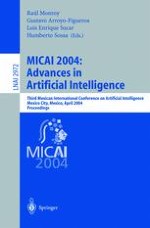2004 | Buch
MICAI 2004: Advances in Artificial Intelligence
Third Mexican International Conference on Artificial Intelligence, Mexico City, Mexico, April 26-30, 2004. Proceedings
herausgegeben von: Raúl Monroy, Gustavo Arroyo-Figueroa, Luis Enrique Sucar, Humberto Sossa
Verlag: Springer Berlin Heidelberg
Buchreihe : Lecture Notes in Computer Science
Enthalten in: Professional Book Archive
